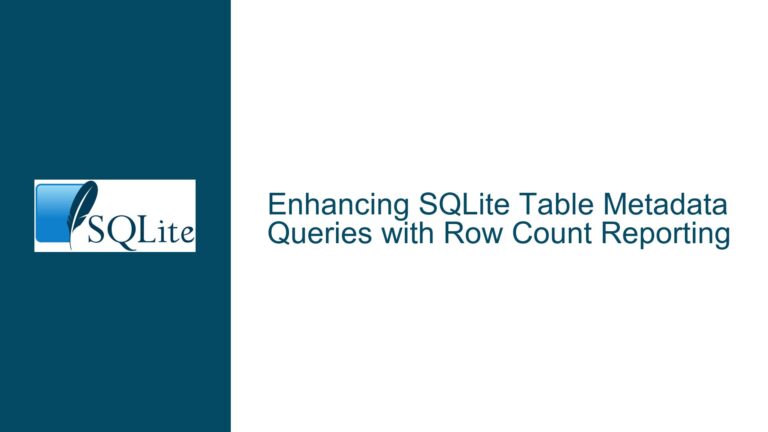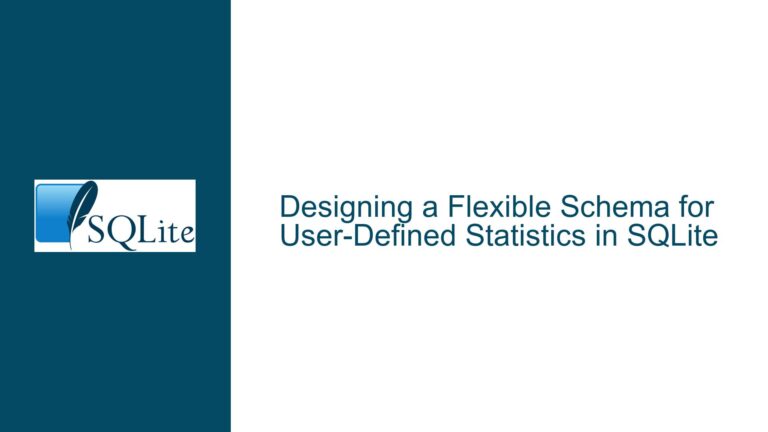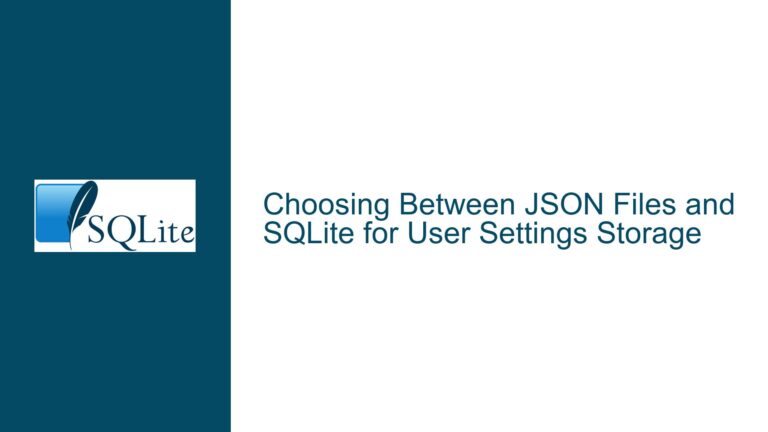SQLite Varint Encoding: SQLite3 vs. SQLite4 Differences and Troubleshooting
Issue Overview: Misleading Documentation and Confusion Between SQLite3 and SQLite4 Varint Encoding
The core issue revolves around the confusion and misleading documentation regarding the variable-length integer (varint) encoding schemes used in SQLite3 and SQLite4. The discussion highlights a discrepancy between the documented behavior of varint encoding in SQLite4 and the actual implementation in SQLite3. This confusion arises primarily because the documentation for SQLite4’s varint encoding appears prominently in search results, leading users to mistakenly apply SQLite4’s rules to SQLite3’s implementation.
SQLite3 and SQLite4 use fundamentally different approaches to encode variable-length integers. SQLite3’s varint encoding is designed to be compact and efficient, using a scheme where the high-order bit of each byte indicates whether the next byte is part of the integer. This allows for a variable number of bytes to represent integers of varying sizes, with a maximum of 9 bytes for a 64-bit integer. On the other hand, SQLite4’s varint encoding introduces a more complex scheme with specific properties aimed at optimizing certain use cases, such as encoding integers up to 240 in a single byte. However, SQLite4 was an experimental version and is no longer actively developed, making its documentation largely irrelevant for current SQLite3 users.
The confusion is exacerbated by the fact that the SQLite4 varint documentation is the first result in many search queries, leading users to misinterpret the encoding rules for SQLite3. This misunderstanding can result in incorrect implementations, bugs, and performance issues when working with SQLite3 databases. Additionally, the discussion touches on the lack of available benchmarks or detailed discussions comparing the performance and trade-offs of SQLite3’s and SQLite4’s varint encoding schemes, making it difficult for developers to make informed decisions when designing their own binary encoding formats.
Possible Causes: Documentation Ambiguity and Version-Specific Encoding Schemes
The primary cause of the issue is the ambiguity in documentation and the lack of clear differentiation between SQLite3 and SQLite4 varint encoding schemes. The SQLite4 varint documentation is prominently displayed in search results, which can mislead users into applying SQLite4’s rules to SQLite3’s implementation. This is particularly problematic because SQLite4 was an experimental version that is no longer actively developed, and its encoding scheme is not relevant to the widely used SQLite3.
Another contributing factor is the complexity of varint encoding itself. Variable-length integer encoding is a nuanced topic, and the differences between SQLite3’s and SQLite4’s approaches are subtle but significant. SQLite3’s encoding is designed for simplicity and efficiency, using a straightforward scheme where the high-order bit of each byte indicates whether the next byte is part of the integer. In contrast, SQLite4’s encoding introduces additional complexity to optimize for specific use cases, such as encoding integers up to 240 in a single byte. This added complexity can make it difficult for developers to understand and implement the correct encoding scheme, especially when the documentation is unclear or misleading.
The lack of available benchmarks or detailed discussions comparing the performance and trade-offs of SQLite3’s and SQLite4’s varint encoding schemes further compounds the issue. Without this information, developers are left to speculate about the advantages and drawbacks of each approach, which can lead to suboptimal design decisions when implementing their own binary encoding formats.
Troubleshooting Steps, Solutions & Fixes: Clarifying Varint Encoding and Avoiding Common Pitfalls
To address the confusion and ensure correct implementation of varint encoding in SQLite3, it is essential to clarify the differences between SQLite3’s and SQLite4’s encoding schemes and provide clear guidance on how to work with SQLite3’s varint encoding. Here are the steps to troubleshoot and resolve the issue:
1. Understand SQLite3’s Varint Encoding Scheme:
SQLite3’s varint encoding is designed to be compact and efficient, using a scheme where the high-order bit of each byte indicates whether the next byte is part of the integer. The encoding rules are as follows:
- If the high-order bit of a byte is set (i.e., the byte is greater than or equal to 128), the next byte is part of the integer.
- If the high-order bit is clear (i.e., the byte is less than 128), the byte is the last byte of the integer.
- The lower seven bits of each byte are used to reconstruct the 64-bit integer.
- The maximum number of bytes used to encode a 64-bit integer is 9.
To correctly decode a varint in SQLite3, you need to read each byte, check the high-order bit, and accumulate the lower seven bits until you encounter a byte with the high-order bit clear. This scheme is straightforward and efficient, making it well-suited for SQLite3’s use cases.
2. Avoid Misapplying SQLite4’s Varint Encoding Rules:
SQLite4’s varint encoding introduces a more complex scheme with specific properties aimed at optimizing certain use cases. However, SQLite4 is no longer actively developed, and its encoding scheme is not relevant to SQLite3. To avoid confusion, always refer to the official SQLite3 documentation for varint encoding: SQLite3 Varint Documentation.
When working with SQLite3, ignore the SQLite4 varint documentation, even if it appears prominently in search results. Applying SQLite4’s encoding rules to SQLite3 can lead to incorrect implementations, bugs, and performance issues.
3. Implement Correct Varint Encoding and Decoding:
To ensure correct implementation of varint encoding in SQLite3, follow these steps:
- Encoding: When encoding a 64-bit integer as a varint, start with the least significant byte and work your way up. For each byte, set the high-order bit if there are more bytes to follow. The lower seven bits of each byte should contain the relevant bits of the integer.
- Decoding: When decoding a varint, read each byte and check the high-order bit. If the high-order bit is set, accumulate the lower seven bits and continue to the next byte. If the high-order bit is clear, accumulate the lower seven bits and stop.
Here is an example of how to decode a varint in SQLite3 using the sqlite3GetVarint function from the SQLite3 source code:
u8 sqlite3GetVarint(const unsigned char *p, u64 *v){
u32 a,b,s;
if( ((signed char*)p)[0]>=0 ){
*v = *p;
return 1;
}
if( ((signed char*)p)[1]>=0 ){
*v = ((u32)(p[0]&0x7f)<<7) | p[1];
return 2;
}
// Continue decoding for larger integers...
}
4. Benchmark and Compare Encoding Schemes for Custom Implementations:
If you are designing a binary encoding format for a hobby project or other use case, consider benchmarking and comparing different varint encoding schemes to determine the best approach for your specific needs. While SQLite3’s encoding is simple and efficient, SQLite4’s encoding offers certain advantages, such as encoding integers up to 240 in a single byte. However, these advantages come at the cost of additional complexity and potential performance overhead.
To make an informed decision, implement both encoding schemes and measure their performance in terms of encoding/decoding speed, storage efficiency, and compatibility with your use case. Share your findings with the community to contribute to the collective knowledge and help others make informed decisions.
5. Contribute to Documentation Improvements:
If you encounter ambiguities or inconsistencies in the SQLite documentation, consider contributing to its improvement. The SQLite project is open-source, and contributions from the community are welcome. By clarifying the documentation and providing examples, you can help prevent others from encountering the same issues and improve the overall quality of the SQLite ecosystem.
In conclusion, the confusion surrounding SQLite3 and SQLite4 varint encoding stems from misleading documentation and the complexity of the encoding schemes themselves. By understanding the differences between the two versions, avoiding misapplication of SQLite4’s rules, and implementing correct encoding and decoding procedures, you can ensure accurate and efficient handling of varints in SQLite3. Additionally, benchmarking and contributing to documentation improvements can further enhance the understanding and implementation of varint encoding in the broader community.






